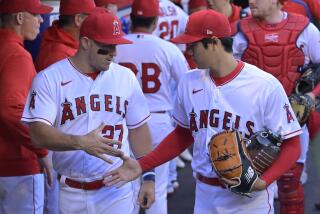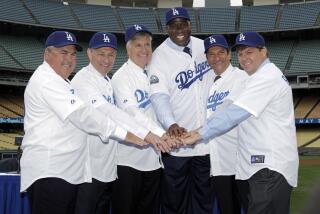Cubs Trying to Figure How They Managed to Get So Far Off Track
- Share via
CHICAGO — It isn’t easy being Green.
Especially if you are the president and general manager of the Chicago Cubs.
At this time of the year, Dallas Green, the head man for the Cubs, was hoping to be making plans for playoff and World Series games.
Instead, Green and the Cubs’ hierarchy must be shaking their heads at the turn of events for the club after they were the toast of a cable-wired country when they won the National League East Division crown in 1984.
“Sure, we’re disappointed,” Green says. “Looking back, we could have all done more. The front office, the manager, the players.”
It was a summer of disappointment. A summer of missed opportunities, of injuries, of failures.
Green probably knew he had to cash in big in 1985. He had a veteran club, buoyed by the signing of three free agent pitchers, Rick Sutcliffe, Dennis Eckersley and Steve Trout.
But a funny thing happen to that trio on the way to the bank. They all were injured for large chunks of this season and the Cubs’ fortunes plummeted as their days on the disabled list mounted.
Cubs’ fans will say the pitching staff injuries cost them a chance to contend in September. Critics argue they weren’t matching their 1984 performances and with the offensive firepower defused, the Cubs were only slightly better than the pre-1984 championship days.
“I haven’t moaned all year, have I?” Manager Jim Frey said. “But I know that on June 13, we were 15 games over .500, our pitchers were coming back and we were one game away from having the best record in baseball. Then things didn’t go so well.”
Green did everything he could. He kept a low profile, then tried to charge up the troops by suggesting on the day the two-day strike was over that some players weren’t doing their best. He even shouldered some of the blame.
“Maybe we should have done more in the way of a trade,” Green says.
But Frey doubts that would have made a difference.
“Everyone says we should have made a trade. But it isn’t that easy,” Frey says.
Green concedes clubs weren’t willing to talk to the Cubs about deals the way they were before 1984 when the club was still a perennial loser.
“Teams aren’t going to help you once you’ve won,” Green says. “It’s easy to beat a club when it’s down.”
Still, decisions made by the Cubs throughout the 1985 season didn’t seem to have the same magic they did in 1984.
The Cubs opted to replace veteran Larry Bowa at shortstop with rookie Shawon Dunston at the start of the season. Dunston wasn’t ready to hit major league pitching and was back at Des Moines, Iowa, in May.
When Sutcliffe initially went out with a pulled hamstring in late May, the club went with a more liberal physical diagnosis and allowed him to return after three weeks. The original doctor to examine him suggested up to six weeks.
Sutcliffe would go on to be hurt two more times and never completely recovered physically.
The same was true with Trout. He would miss a start, pitch well for two weeks, then miss two starts. Instead of complete rest, Trout was in and out of the rotation. Like Sutcliffe, he never recovered physically.
To compensate for the loss of Trout and Sutcliffe, Eckersley “shouldered” most of the burden. He later wound up with a cortisone shot in his ailing shoulder.
Green & Co.’s most difficult--and possibly most important--decisions are ahead.
Do the Cubs gamble and stay pat, hoping the injury-plagued staff will come back healthy in 1986?
Or does Green go back and wheel and deal as he did in his first years at the Cubs’ helm?
“These are all decisions we’re going to have to make,” Green says.
Green has to decide whether to pay outfielder Gary Matthews and pitcher Scott Sanderson big money. Matthews will be 36 and Sanderson has had a bad back for two years. Green already has said he won’t break the Chicago Tribune Co. bank to do that.
He has a left side of an infield in Dunston and a third baseman, Ron Cey, who has slowed considerably.
If he does deal, who is expendable? Leon Durham at first base still carries considerable trade weight and at age 29 is still carrying the tag “promising.”
Ryne Sandberg and Jody Davis figure to be untouchables. Keith Moreland’s stock is up and he is considered to be the club’s MVP this year.
He could deal some pitching but those fat salaries are turnoffs to other clubs.
But Green has faced challenges before and actually flourishes in tough times.
More to Read
Go beyond the scoreboard
Get the latest on L.A.'s teams in the daily Sports Report newsletter.
You may occasionally receive promotional content from the Los Angeles Times.










